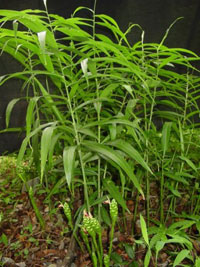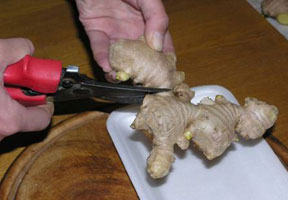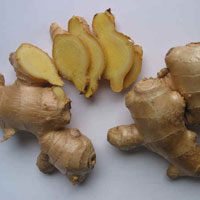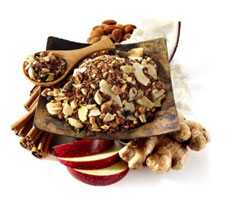 History
History
This spice was known in India for a very long time. Ayurveda classifies this plant as a universal remedy used for many diseases: digestive problems, including intestinal infections, migraines, nausea. It is known that during periods of plague and cholera epidemics, the population of this country began to consume more spices for food, including ginger.
In Chinese medicine, ginger was included in many recipes for the elderly, as a plant that restores vitality and warms. And fishermen, going to sea, took with them a piece of raw or candied rhizome - as a remedy for seasickness.
During the time of the ancient Greeks and Romans, ginger was used as a spice and medicine. It is mentioned by Dioscorides and Pliny. Dioscorides treated them with diseases of the gastrointestinal tract, the Romans - eye diseases.
The Arabs used a decoction of the roots for angina and loss of voice. According to linguists, the Latin name of the plant “Zingiber"Comes from Arabic"Zindschabil", Which means" root ".
This is one of the first spices brought to Europe from Asia. The abbess of a Benedictine monastery and at the same time the author of one of the first books on herbal medicine in medieval Europe, Hildegard Bingen (1098-1179) recommended ginger as a tonic and stimulant. In the Middle Ages, it was used to prevent plague and hysteria.
By the way, this was the first Asian spice that moved to America and took root there well. During the development of America by the Spanish colonialists, among other plants, they began to grow ginger there - the tropical climate contributed to this. In 1547, more than 2 tons of ginger rhizomes were brought to Spain from the West Indies.
In England, ginger took root as a spice and was added to ale and puddings, and in London there was even Gingerstreet.
In Russia, without ginger and cloves, the preparation of Tula gingerbread and mead was unthinkable.
Botanical description
Ginger (Zingiber officinale Rosc.) - a tropical herbaceous perennial from the Ginger family, outwardly somewhat resembling a reed. Rhizomes are creeping, knobby, fleshy. Stems reach 2 m. Dense, short spike-shaped inflorescences consist of a stem covered with covering leaves, tiled-overlapping one another, and axillary single flowers of white, yellow or pink, resembling an orchid in shape. Only one stamen is developed, adherent to the petal. Instead of the rest of the stamens, underdeveloped staminodes. One pistil, lower ovary. The fruit is a tricuspid capsule.
Homeland and distribution around the world
His homeland is South Asia, although he is not found in the wild. Cultivated in China, India, Indonesia, Ceylon, Australia, West Africa, as well as Jamaica and Barbados.
The largest producers of ginger (2005 data): Nigeria (area 181,000 ha and production 125,000 tonnes) and India (areas 95,300 ha and production 359,000 tonnes). The largest exporter is China 232,000 tons. Jamaican ginger is highly valued for its delicate aroma.
Ginger plantations are laid under the canopy of trees with pieces of rhizomes. Harvesting begins within 245-260 days after planting. But this young ginger is only used in cooking. For long-term storage as a spice and to obtain essential oil, the rhizomes are dug out 9-10 months after planting, when the leaves turn yellow and the rhizome skin acquires a greenish or brown color. The ginger is harvested by hand (except in the USA).
 What is used
What is used
Spice and medicinal raw materials are ginger rhizomes, which look like finger-separated, rounded or squeezed pieces that resemble different figures. Depending on the processing method, the raw materials are divided into black (it is also sometimes called "Barbados") - unpeeled, not scalded with boiling water and dried in the sun, and white ("Bengal") - washed and peeled ginger. The first is characterized by a stronger odor and a pungent taste. But most often this spice is sold in powder, which has a grayish-yellow color and a mealy consistency. Essential oil, which is obtained from rhizomes by steam distillation, is widely used by aromatherapists.
Sometimes unscrupulous suppliers instead of ginger sell alpinia officinalis (Alpinia officinarum), but it differs in thicker red-brown rhizomes with white leaf scars and pronounced remnants of shoots.
What contains
The characteristic smell of ginger is given by essential oils, which contain 1-3%, and the pungent taste is given by gingerol. In addition, rhizomes contain starch, sugar, and resin.
Essential oil contains the following components:camphene, d-pellandrene, tsingiberen, cineole, borneol, linalool, citral. The aroma is similar to camphor, pungent, with lemon notes. The essential oil is obtained from rhizomes with roots by hydrodistillation. The oil is a pale yellow, amber or greenish liquid. It differs depending on the origin, for example, African - darker.
It should be noted that the essential oil of ginger does not have a sharp taste and irritating effect on the skin of a whole rhizome, which is due to the fact that gingerol does not pass into it during distillation.
How does it heal?
Fresh rhizome or powderit is used for colds, has antimicrobial activity against pathogens of many diseases. However, it should be remembered that essential oil almost does not have this effect. Therefore, in case of intestinal infections and poisoning, it is better to use rhizomes, and not essential oil, as aromatherapists sometimes recommend.
Since ancient times, Chinese doctors have prescribed ginger to elderly patients with memory impairments, cold extremities, and after strokes. They recommended using this plant in combination with garlic, believing that they enhance each other's action. Modern research has confirmed that its drugs improve blood circulation and serve to prevent thrombosis. O.D. Barnaulov et al. Recommends ginger for memory loss, intelligence, encephalopathy, tinnitus, headache, strokes, paralysis, Alzheimer's disease, chronic arachnoiditis, rheumatoid arthritis, as well as ovarian hypofunction and hypothyroidism.
The use of ginger preparations in studies reduced cholesterol.
The use of ginger as an anti-inflammatory and pain reliever for colds has also found a scientific explanation. The hydroalcoholic extract of ginger reduced the level of prostaglandins and suppressed inflammation in the case of pneumonia induced in rats.
Homemade recipes
 The pungent taste of ginger aids digestion by stimulating the production of gastric juices. Therefore, it is used for digestive disorders, accompanied by nausea, vomiting, diarrhea, and chronic enteritis. In case of dysentery, the Chinese take 0.3-0.5 g (at the tip of a knife) of ground rhizome 4 times a day.
The pungent taste of ginger aids digestion by stimulating the production of gastric juices. Therefore, it is used for digestive disorders, accompanied by nausea, vomiting, diarrhea, and chronic enteritis. In case of dysentery, the Chinese take 0.3-0.5 g (at the tip of a knife) of ground rhizome 4 times a day.
The Chinese also believe that this spice improves memory, especially in old age. They also recommend ginger powder with honey as an indispensable remedy for male problems. Take a powder with honey daily and wash it down with tea. There is information about the use of this plant for prostatitis.
Ginger is one of the most effective remedies for motion sickness in transport. In the experiment, it has proven itself better than many approved medications designed for this purpose. It is best to use a slice of fresh or candied rhizome. Some sources recommend it for morning sickness of pregnant women, but in this case, you need to be very careful with the use and consult a doctor.
Along with the powder, you can use a ginger tincture with vodka (in a ratio of 1:10). It is advisable to use it for any intestinal disorders and indigestion.
If you want to make ginger tea, take half a teaspoon of the powder, pour 2 cups of boiling water, simmer in a sealed enamel bowl for 40 minutes, strain, add sugar to taste, or preferably honey, and drink like tea.This dosage form is more desirable for colds.
When using ginger as a cold remedy, you can make ginger, something like our mustard plaster. Rub fresh ginger root, spread it on compress paper and apply in the same way as a mustard plaster. In the same way, compresses are used for joint diseases, myositis and neuralgia. If there is no fresh ginger, then take the rhizome powder, pour a small amount of boiling water and spread the resulting gruel on compress paper.
For gourmets, I highly recommend adding a little ginger and 2-3 cloves to the coffee. This drink, brewed with spices and drunk in a pleasant company, will give you vigor and improve your mood.
Aromatherapists use ginger essential oil for diseases of the gastrointestinal tract, for sprains, for sluggish circulation, in skin care products and for stress relief.
But like any medicine, ginger has a number of restrictions on its use. It should not be used during pregnancy, including as an antiemetic for toxicosis. Essential oil is not used in its pure form, but is diluted with base oils. Otherwise, it can cause irritation.
 For gourmets
For gourmets
Perhaps no kitchen in the world ignores ginger. In Asian countries, it is found in curries and some other spice mixtures. In Chinese cuisine, such a dish as pork in a sweet sauce with ginger is widely known, it not only aromas the meat, but also makes it softer and more tender. In Vietnam and Burma, jam is made from fresh roots. Ginger jam with orange peels is very popular. In India, four varieties of "ginger flour" are produced, which differ in the amount of added spice. In Arabic cuisine, it is added to dough and candied ginger is made - candied fruit. European cuisine uses this spice mainly in the preparation of sauces for meat, vegetable and fruit marinades.
Ginger was also favored in Russia. Without it, Russian sbitni, kvass, liqueurs, honey would have lost their taste. It is still added to the dough of gingerbread, Easter cakes and buns.
By the way, if you want to use ginger in your culinary delights, consider some subtleties. On the advice of a great connoisseur of culinary traditions and subtleties V.V. Pokhlebkin, ginger is introduced into the dough during kneading. When stewing meat - 20 minutes before cooking, and in compotes, puddings, jelly - 2-5 minutes before cooking. Fresh ginger leaves are added to salads and teas for a pleasant aroma.
For those who like to grow
Medicinal ginger a rather grateful object for growing on a windowsill, and many enthusiasts successfully get a harvest, albeit a small one, but such a heartwarming crop for any plant lover.
Ginger is a very thermophilic houseplant, does not like drafts and is strongly oppressed at a temperature of + 15-16 ° C. He prefers loose, light-textured and organic-rich soils. A mixture of turf and leafy soil, peat and coarse river sand in equal parts is best suited. Reproduces vegetatively. The planting stock can be purchased from the vegetable section of the supermarket, where fresh ginger is available for sale. Pay attention in winter so that the rhizomes are not frozen. They are divided into pieces so that each has a healthy and well-developed kidney, and planted in pots. It is possible in not very deep, but with a large diameter, so that it has where to crawl in breadth. Better yet, use wide pallets. Rhizomes are planted superficially, like irises, only lightly sprinkled with earth.
Ginger is a very spectacular plant, it gives a lot of greenery, and you will get a lot of positive emotions from the abundance of greenery even before the harvest. Well, if it also blooms! ... Ginger is relatively undemanding by the light, because in its homeland it grows under the canopy of tropical vegetation.Ginger will grow even on the windowsills of the windows of the northeast and northwest exposure. Plants prefer high air humidity, so it is advisable to spray them 1-2 times a day from a spray bottle, especially in winter, when central heating is turned on. Fertilizers are mineral complexes that necessarily include the maximum variety of microelements.
At low temperatures (below + 15 ° C), the plant can fall into a dormant state until spring. But if the temperature in the apartment is constant about + 20 ° C or more, it behaves like an evergreen perennial, although in winter the leaves still partially turn yellow.
It is recommended to dig out the rhizomes when the leaves turn yellow. After that, they are washed and used in home cooking.
 History
History What is used
What is used For gourmets
For gourmets








